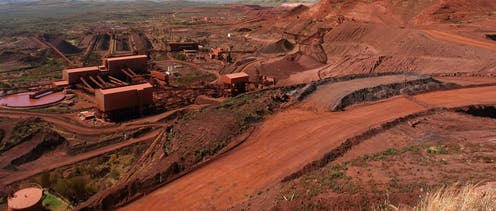Rio Tinto (NYSE:RIO) reported its weakest first-quarter iron ore shipments since 2019, as severe tropical cyclones disrupted its Pilbara operations in Western Australia. The mining giant shipped 70.7 million metric tons (Mt) of iron ore in Q1 2025, down from 78 Mt a year earlier, falling short of the 73.6 Mt forecast by analysts at Visible Alpha.
The company now expects full-year Pilbara iron ore shipments to land at the lower end of its 323 Mt to 338 Mt guidance range. Rio Tinto warned that further weather-related disruptions could increase the risk of missing its 2025 targets. The miner had already flagged potential production losses of up to 13 Mt in the quarter due to storm-related shutdowns at Dampier port.
Rio Tinto also cited limited flexibility in its system to recover from additional losses without delays in approvals for new mining areas and heritage clearances. Meanwhile, the company has been increasing shipments of lower-grade ore while developing its next-generation mines.
This slowdown puts Rio Tinto at risk of being overtaken by Brazil’s Vale (NYSE:VALE), which maintained its 2025 guidance of 325 Mt to 335 Mt. If Vale hits the top end of its range, it could reclaim the title of the world’s leading iron ore producer.
On the copper front, Rio Tinto’s consolidated production rose 16% year-on-year to 210,000 tonnes, though it slipped 8% from Q4 2024. At the Kennecott mine in Utah, copper output dropped 32% quarter-on-quarter due to unplanned conveyor failures but rose 7% year-on-year. The company confirmed the conveyor system is now fully operational.



 Boeing Acquisition of Spirit AeroSystems Could Close Soon Amid Ongoing Conditions
Boeing Acquisition of Spirit AeroSystems Could Close Soon Amid Ongoing Conditions  YouTube Agrees to Follow Australia’s New Under-16 Social Media Ban
YouTube Agrees to Follow Australia’s New Under-16 Social Media Ban  Australia Moves Forward With Teen Social Media Ban as Platforms Begin Lockouts
Australia Moves Forward With Teen Social Media Ban as Platforms Begin Lockouts  Amazon Italy Pays €180M in Compensation as Delivery Staff Probe Ends
Amazon Italy Pays €180M in Compensation as Delivery Staff Probe Ends  Spirit Airlines Reverses Pilot Furlough Plans Amid Updated Staffing Outlook
Spirit Airlines Reverses Pilot Furlough Plans Amid Updated Staffing Outlook  Wikipedia Pushes for AI Licensing Deals as Jimmy Wales Calls for Fair Compensation
Wikipedia Pushes for AI Licensing Deals as Jimmy Wales Calls for Fair Compensation  Hikvision Challenges FCC Rule Tightening Restrictions on Chinese Telecom Equipment
Hikvision Challenges FCC Rule Tightening Restrictions on Chinese Telecom Equipment  Airbus Faces Pressure After November Deliveries Dip Amid Industrial Setback
Airbus Faces Pressure After November Deliveries Dip Amid Industrial Setback  Netflix’s $72 Billion Warner Bros Discovery Deal Reshapes the Entertainment Landscape
Netflix’s $72 Billion Warner Bros Discovery Deal Reshapes the Entertainment Landscape  UPS MD-11 Crash Prompts Families to Prepare Wrongful Death Lawsuit
UPS MD-11 Crash Prompts Families to Prepare Wrongful Death Lawsuit  GM Issues Recall for 2026 Chevrolet Silverado Trucks Over Missing Owner Manuals
GM Issues Recall for 2026 Chevrolet Silverado Trucks Over Missing Owner Manuals  Lockheed Martin Secures $1.14 Billion Contract Boost for F-35 Production
Lockheed Martin Secures $1.14 Billion Contract Boost for F-35 Production  OpenAI Moves to Acquire Neptune as It Expands AI Training Capabilities
OpenAI Moves to Acquire Neptune as It Expands AI Training Capabilities  Tesla Faces 19% Drop in UK Registrations as Competition Intensifies
Tesla Faces 19% Drop in UK Registrations as Competition Intensifies  Tesla Expands Affordable Model 3 Lineup in Europe to Boost EV Demand
Tesla Expands Affordable Model 3 Lineup in Europe to Boost EV Demand  ExxonMobil to Shut Older Singapore Steam Cracker Amid Global Petrochemical Downturn
ExxonMobil to Shut Older Singapore Steam Cracker Amid Global Petrochemical Downturn  IKEA Expands U.S. Manufacturing Amid Rising Tariffs and Supply Chain Strategy Shift
IKEA Expands U.S. Manufacturing Amid Rising Tariffs and Supply Chain Strategy Shift 































